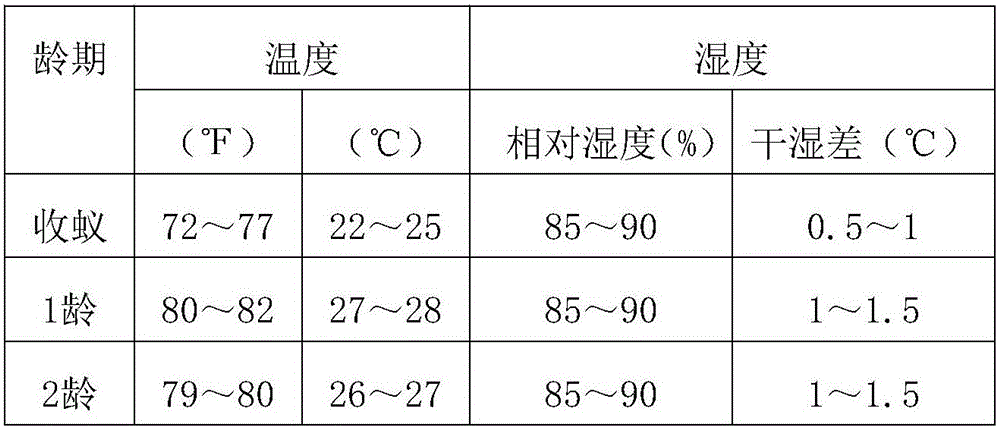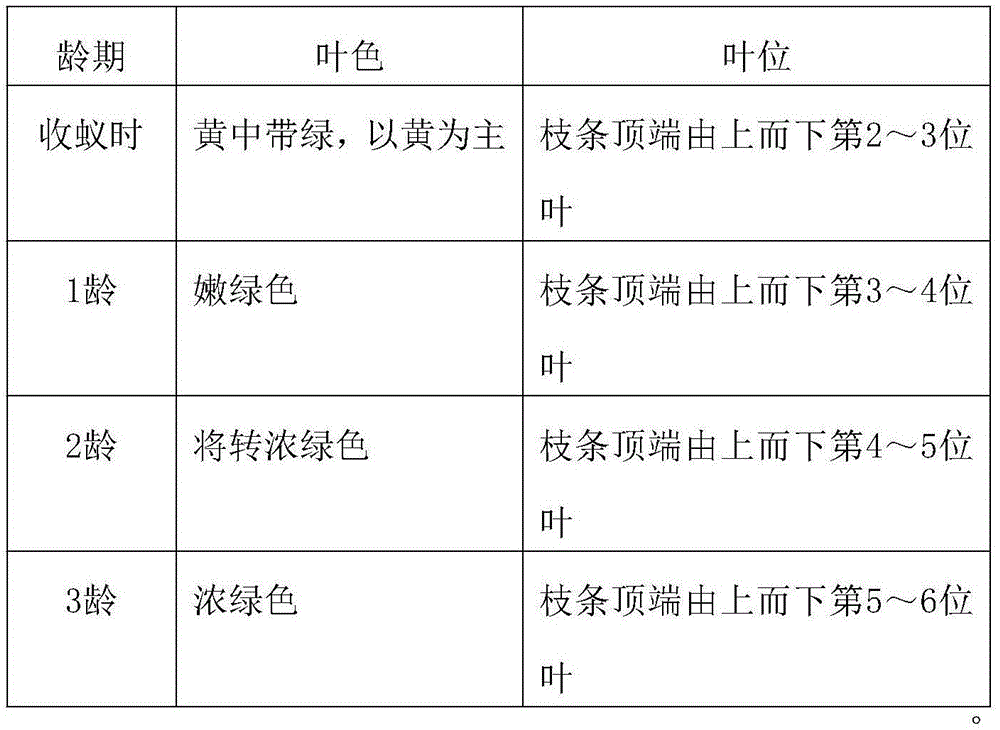Young silkworm cooperative-rearing method determining newly-hatched silkworm amount based on egg amount and adopting mulberry leaf attraction based newly-hatched silkworm collecting method
A technology of co-breeding small silkworms and ants silkworms, which is applied in the field of silkworm breeding, can solve the problems of unscientific operation methods of co-breeding small silkworms, labor-intensive cultivation methods, and low silkworm egg production, so as to increase silkworm egg production and save The effect of reducing the probability of labor and injury
- Summary
- Abstract
- Description
- Claims
- Application Information
AI Technical Summary
Problems solved by technology
Method used
Image
Examples
Embodiment 1
[0042] The steps of collecting ants include:
[0043] Spreading seeds: take a silkworm box with a length of 1.1 meters and a width of 0.8 meters, and put black paper on it, with the colored side of the black paper facing down, pour the silkworm eggs into the silkworm box and place them evenly into 4 plots, and divide each plot with goose feathers. Sweep the silkworm eggs and form a rectangle with a length of 20 cm and a width of 15 cm. Spread a circle of lime powder with a width of 2 cm and a thickness of 1 mm on the periphery of the silkworm eggs in each plot. The edge of the lime powder is 6 cm away from the side of the rectangular silkworm eggs. ;
[0044] Darkness protection: Align and stack the silkworm boxes with laid silkworm eggs up and down, and cover the stacked silkworm boxes with a moist black cloth to completely block the light at the doors and windows;
[0045] Photosensitive: Turn on the light at 4 o'clock in the morning on the third day after the silkworms hat...
Embodiment 2
[0063] The steps of collecting ants include:
[0064] Spreading seeds: take a silkworm box with a length of 1.1 meters and a width of 0.8 meters, and put black paper on it, with the colored side of the black paper facing down, pour the silkworm eggs into the silkworm box and place them evenly into 4 plots, and divide each plot with goose feathers. Sweep the silkworm eggs and form a rectangle with a length of 20 cm and a width of 15 cm. Spread a circle of lime powder with a width of 2 cm and a thickness of 1 mm on the periphery of the silkworm eggs in each plot. The edge of the lime powder is 6 cm away from the side of the rectangular silkworm eggs. ;
[0065] Darkness protection: Align and stack the silkworm boxes with laid silkworm eggs up and down, and cover the stacked silkworm boxes with a moist black cloth to completely block the light at the doors and windows;
[0066] Photosensitive: Turn on the light at 4 o'clock in the morning on the third day after the silkworms hat...
Embodiment 3
[0085] The steps of collecting ants include:
[0086] Spreading seeds: take a silkworm box with a length of 1.1 meters and a width of 0.8 meters, and put black paper on it, with the colored side of the black paper facing down, pour the silkworm eggs into the silkworm box and place them evenly into 4 plots, and divide each plot with goose feathers. Sweep the silkworm eggs and form a rectangle with a length of 20 cm and a width of 15 cm. Spread a circle of lime powder with a width of 2 cm and a thickness of 1 mm on the periphery of the silkworm eggs in each plot. The edge of the lime powder is 6 cm away from the side of the rectangular silkworm eggs. ;
[0087] Darkness protection: Align and stack the silkworm boxes with laid silkworm eggs up and down, and cover the stacked silkworm boxes with a moist black cloth to completely block the light at the doors and windows;
[0088] Photosensitive: Turn on the light at 4 o'clock in the morning on the third day after the silkworms hat...
PUM
 Login to View More
Login to View More Abstract
Description
Claims
Application Information
 Login to View More
Login to View More - R&D
- Intellectual Property
- Life Sciences
- Materials
- Tech Scout
- Unparalleled Data Quality
- Higher Quality Content
- 60% Fewer Hallucinations
Browse by: Latest US Patents, China's latest patents, Technical Efficacy Thesaurus, Application Domain, Technology Topic, Popular Technical Reports.
© 2025 PatSnap. All rights reserved.Legal|Privacy policy|Modern Slavery Act Transparency Statement|Sitemap|About US| Contact US: help@patsnap.com



